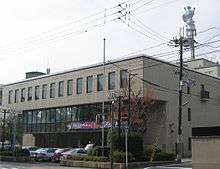Kyoto Broadcasting System
Kyoto Broadcasting System Company, Ltd (株式会社京都放送, Kabushiki-gaisha Kyōto Hōsō, KBS) is a commercial broadcasting station headquartered in Kyoto, Japan. It is doing business in Kyoto Prefecture as "KBS Kyoto" (KBS京都) and in Shiga Prefecture as "KBS Shiga" (KBS滋賀)
| Kyoto, Kyoto Prefecture Japan | |
|---|---|
| Channels | Digital: 23 (UHF) Virtual: 5 |
| Branding | KBS |
| Ownership | |
| Owner | Kyoto Broadcasting System |
| History | |
| Founded | June 26, 1951 |
| First air date | April 1, 1969 |
| Former channel number(s) | Analog: 34 (UHF, 1969–2011) |
| Call sign meaning | Kyoto BRoadcasting |
| Links | |
| Website | www |

Its radio station serves Kyoto and Shiga Prefectures and is a member of National Radio Network (NRN). Its television station serves Kyoto Prefecture and is a member of the Japanese Association of Independent Television Stations (JAITS). Since April 1, 2005, KBS is broadcasting digital television in ISDB format.
Broadcasting
AM Radio
KBS Kyoto Radio (京都放送ラジオ)
- Kyoto - 1143 kHz, 50 kW, JOBR
- Maizuru - 1215 kHz, 2 kW, JOBO
- Fukuchiyama - 1485 kHz, 100 W, JOBE
- KBS Shiga (Hikone) - 1215 kHz, 1 kW, JOBW, some prefectural programming.
FM Radio
94.9 MHz 3 kW
TV (Analogue)
JOBR-TV - KBS Kyoto Television (京都放送テレビジョン)
- Kyoto - Channel 34, 10 kW
- Uji-Momoyama - Channel 57
- Maizuru - Channel 57, 100 W
- Fukuchiyama - Channel 56, 200 W
- Miyazu - Channel 39, 100 W
- Yamashina - Channel 62, 10 W
- Wazuka - Channel 40, 10 W
- Yawata - Channel 43, 3 W
- Kameoka - Channel 41, 300 W
and more
TV (Digital)
JOBR-DTV - KBS Kyoto Digital Television (京都放送デジタルテレビジョン)
- Remote Controller ID 5
- Kyoto - Channel 23
History
Main source:[1]
- 24 December 1951: 京都放送 (Kyōto Hōsō, KHK) opens as Radio Kyoto (ラジオ京都, Rajio Kyōto).
- 1964: Changes company name to Kinki Broadcasting System (近畿放送, Kinki Hōsō, KBS).
- 1968: Starts television test transmission from Mount Hiei.
- 1969: Starts television broadcasting service. Networking with Tokyo 12 channel (now TV Tokyo) and Nippon Educational Television (now TV Asahi.) (Currently KBS is not a member of eithers' network.)
- 1981: Began doing business as "KBS Kyoto".
- It was involved with the Itoman fraud case for a certain period of time in 1990s which risked the company to bankruptcy.
- 1994: Some employees went to court for Corporation Reorganization Law (会社更生法, Kaisha Kōsei Hō) to save KBS.
- 1995: Changed to company name to Kyoto Broadcasting System Co., Ltd. (株式会社京都放送, Kabushiki-gaisha Kyōto Hōsō, KBS), reviving the original Japanese name.
- 1999: The corporation reorganization procedure begins.
- 1 April 2005: Starts digital television broadcasting.
- 2007: The corporation reorganization procedure is complete.
- 2008: Well known toy brand Tomy releases a Kyoto Broadcasting System Choro-Q toy van edition
Program
TV
- Horse Racing Live (競馬中継, Keiba chu-kei)
- Kyoto Shimbun News (京都新聞ニュース)
- Kyo Plus (京プラス)
- Kyo Biz (京Biz, Kyo-Bizu)
- GO GO Poppin (GO GO ポッピン, Go-Go- Hoppin)
- Taniguchi na yoru (谷口な夜)
- Running Man (走る男)
- KBS Kyoto Excite Night Game (KBS京都エキサイトナイター, Ke-bi-esu Kyo-to Ekisaitingu Naita-)
- Exciting! J (エキサイティング!J, Ekisaiting Jei), etc...
Radio
- Kōei Shōfukutei's Hot Radio (笑福亭晃瓶のほっかほかラジオ, Shōfukutei Kōei no Hokka Hoka Radio), etc...
- All Night Nippon (produced by Nippon Broadcasting System, Inc. (LF))
- All Night Nippon (Mon. - Sat. from 25:00 until 27:00)
- All Night Nippon Ever Green (Mon. - Thu. from 27:00 until 29:00)
- All Night Nippon R (Fri. and Sat. from 27:00 until 29:00)
- Fukuyama Masaharu All Night Nippon Saturday Special Tamashii no Radio (Sat. from 23:30 until 25:00)
Note: All times are in Japan Standard Time (UTC+9) in this article. The broadcast time can exceed 23:59, this refers to the morning hours of the following day (meaning Mon 27:00 - 29:00 equals Tue 03:00 - 05:00.)
See also
- UHF (Independent UHF Station)
- List of radio stations in Japan
References
- ja:京都放送#沿革 excerpt as of 2007-06-29T11:17